Many gulfs exist worldwide, but the Gulf of Mexico tops the chart.
It is the largest Gulf in the world and has other staggering attractions to stand out among the other oceanic banks.
Being a rich river basin, an estimated 7 million people visit the area annually for tourism, wildlife viewing, and water sports activities such as skiing, boating, fishing, swimming, and many others.
Although home to various attractive wildlife, some of nature’s deadliest creatures exist beneath this huge oceanic basin and surrounding areas. The most dangerous animals in the Gulf of Mexico include bull sharks, sting rays, lionfish, sea urchins, etc.
This article extensively discusses 11 of the deadliest animals you should avoid in the Gulf of Mexico and some safety tips you should know.
What are the Most Dangerous Animals in the Gulf of Mexico?
1. Bull Sharks

- Scientific name: Carcharhinus Leucas
- Classification: Cartilaginous
- Habitat: Coastal waters
- Diet: Carnivore
- Conservation status: Near threatened
Sharks are one of the most dangerous animals you will find roaming most coastal waters, and if there is any species you’ll likely encounter in the Mexican Gulf, it’s the bull shark.
It has the strongest bite force among sharks growing up to 7 to 11 feet and weighing 200 to 500 pounds. It ranks as the 3rd most dangerous shark on the planet, just behind the Great White Shark and the Tiger Shark
As with the characteristics of sharks, what makes them even more deadly is that these creatures aren’t picky eaters and have a thing for curiosity.
So if you’re not careful, there is a high chance you may get attacked by a shark just because it’s exploring a new meal rather than from hunger.
Another thing that makes the bull shark dangerous is that sharks generally have poor vision.
Over 60% of shark victims in the last decade have mostly been swimmers, surfers, and water skiers. It is because from beneath the ocean, sharks tend to mistake them for aquatic life.
One tip to help you so you don’t end up on a bull shark’s menu is to know that sharks are generally active at dawn and dusk. That is when they are usually hungry and go out to hunt.
So it is best you avoid going under the Mexican Gulf during this period.
Sharks are also drawn to light—wearing jewelry or any object that reflects light while swimming or surfing may make you look like a tasty snack to a bull shark from beneath the ocean.
2. Barracuda
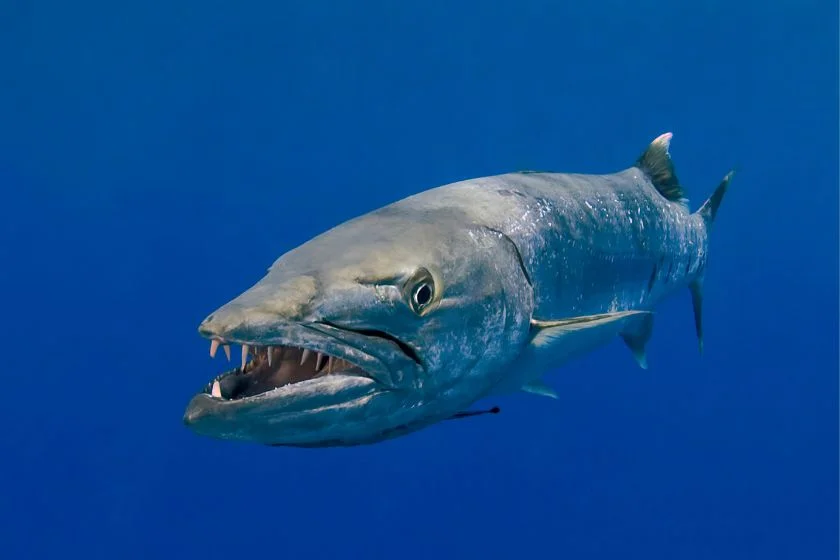
- Scientific name: Sphyraenidae
- Classification: Perch-like fishes
- Habitat: Ocean
- Diet: Carnivore
- Conservation status: Not extinct
With a length of up to five feet long, razor-sharp teeth, and a ferocious temper, the barracuda (also “cuda”) is one dangerous animal you should watch out for when swimming in the Gulf.
Its aggressive behavior can be seen in how they often like to ram into schools of fish when hungry. There are also reports of several kayak attacks by barracudas and divers losing their fingers.
Barracudas have been labeled as ambush hunters, sometimes with frightening bursts of speeds up to 35 miles per hour.
However, much of this is caused by their poor vision, which makes them unpredictable and even more dangerous.
Now, while there may not have been any major report of this dangerous fish causing carnage in the Gulf of Mexico, in nearby city Miami, there has been a testament to what these creatures can do.
Like sharks, they are also attracted by shiny objects, which makes swimming with jewelry in the Mexican Gulf not a good idea unless you’re extremely brave or reckless.
When swimming and you spot a group of barracuda, it is advisable that you remain calm and not make any sudden movements that will startle them.
3. Stingrays
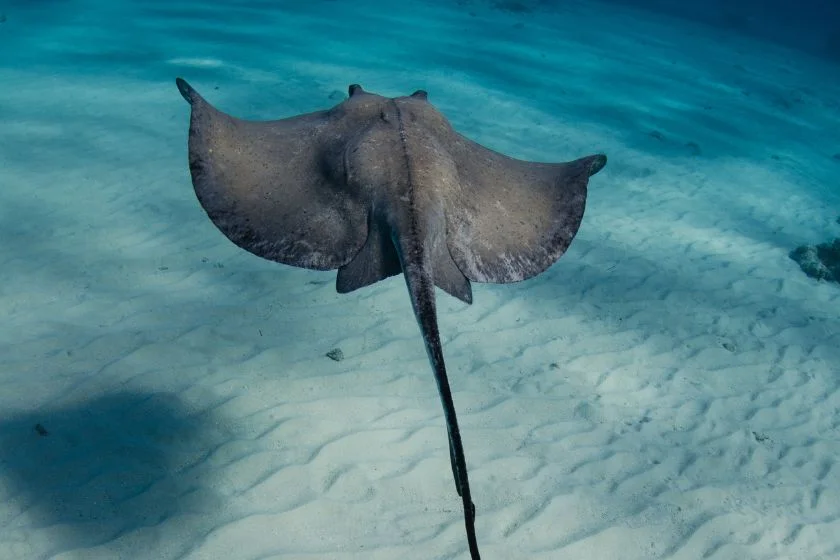
- Scientific name: Myliobatoidei
- Classification: Cartilaginous fish
- Habitat: Shallow coastal waters
- Diet: Carnivore
- Conservation status: Least concern
Another creature you should look out for when surfing or boating in the Gulf of Mexico is stingrays. They seemingly appear as one of the several docile species.
Still, they are not one to play around with. Between 250 to 2000 injuries due to stingrays are reported in the U.S. annually.
These low-key creatures with a flattened shape like a flounder are closely related to sharks. Their flattened shape helps them to conceal perfectly under the sand, where they sometimes lie in wait for the unsuspecting.
Stingrays can deliver a nasty sting, which can inject a potent poison that can cause intense pain, vomiting, muscle cramps, and swelling in victims—sometimes even death if no prompt medical attention is given.
Divers and swimmers who have encountered the stingray have testified to the powerful and poisonous punch loaded in the sting.
Although the stingray attacks mostly in defense, unlike their closely related siblings, sharks, avoiding these creatures is tricky because they are very good at disguising and would often bury themselves in the sand, making quick detection difficult.
So the best thing to do when swimming in the shallow parts of the Gulf is to shuffle your feet under the dirt to alert them so they can move away.
Or you can also hurl a rock in the area where you want to swim to disperse any stingrays.
4. Lionfish
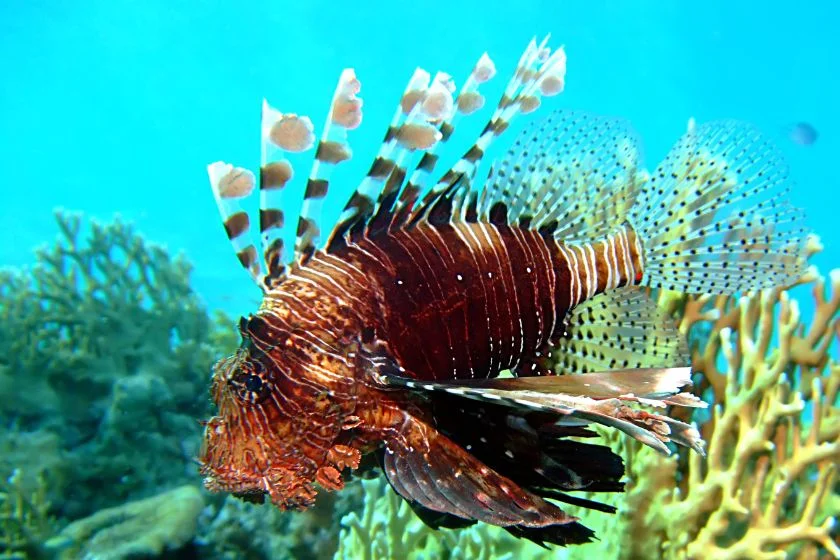
- Scientific name: Pterois
- Classification: Ray-finned fishes
- Habitat: Coastal waters
- Diet: Carnivore
- Conservation status: Non-extinct
If there is a list of dangerous creatures that can deceive with their looks, the Lionfishes should be on the list.
You may not find them in abundance, but they are one of the most dangerous creatures in the Gulf of Mexico due to their invasive nature and beautiful, distinct markings.
They feed on other sea creatures, and their poisonous tentacles carry a powerful punch.
Victims who have had an unpleasant encounter with Lion fishes have complained of swelling in the affected area, intense pain, labored breathing, and even paralysis.
Luckily, avoiding them can be pretty easy due to their distinct markings, which makes them easy to spot.
But sometimes, it can be harder when you get into deeper depths, where these creatures use rocky crevices and reefs as their habitat.
So if you find your find yourself in these areas, please do well to keep an eye on them. Failure to do so, you’ll be reminded in their way.
5. Sea Urchin
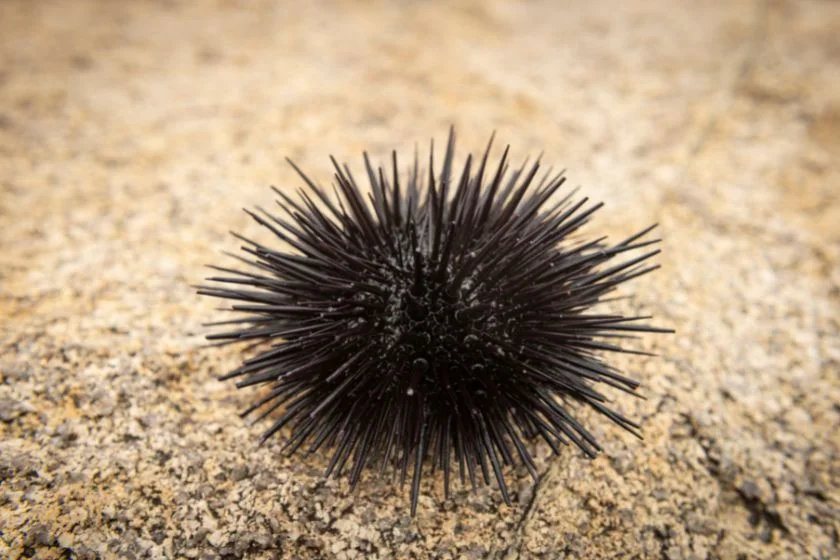
- Scientific name: Echinoidea
- Classification: Echinodermata
- Habitat: Sea floor, Rocks, Reefs
- Diet: Herbivores
- Conservation status: Not extinct
These seemingly harmless creatures are found only in the Gulf’s oceans and warm waters. But don’t be deceived into thinking that being herbivores makes them soft.
Perhaps for purely defensive reasons, these creatures have protruding spines that may require a mini surgery for removal if it pierces and breaks inside your skin.
One sting from the spine may be harmless and cause symptoms such as swelling and blue coloring in the affected area; but when stung more than once, that’s where the story changes!
Victims stung more than once can experience the following:
- Severe and excruciating pain in the affected area
- Fatigue
- Difficulty breathing
- Death
The best way to avoid sea urchins is to be vigilant and careful. Make sure you access areas carefully before stepping on your feet.
And like most sea creatures, sea urchins are nocturnal, and worse is that they’re almost impossible to see at night.
For your safety, ensure you are far away from their habitats, especially at night.
6. Jellyfish
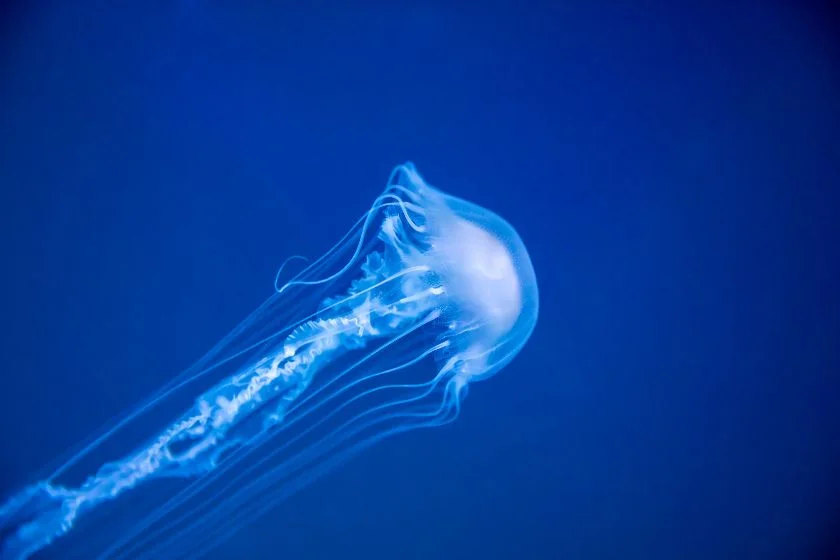
- Scientific name: Scyphozoa
- Classification: Invertebrates
- Habitat: deep sea, ocean, and coastal regions
- Diet: Carnivore
- Conservation status: Least Concern
The jellyfish is one of the most common animals you will find on most beaches and Gulfs.
It is largely because they typically love to ride sea waves, and this activity can navigate them to many coastal gulfs.
These slow translucent creatures may be beautiful to keep in your aquarium and look at, but not to touch or play with.
Jellyfish kill far more people than sharks annually due to their evolved toxin genes.
Some species of jellyfishes, such as the man o’ war, have poisonous tentacles that can only be rivaled by a handful of creatures administering potent poison to victims.
The sting from their tentacles is very dangerous and capable of causing even death. Swimmers have been recorded to be their highest victims.
Although jellyfish attacks are relatively rare in the Gulf of Mexico, there have been numerous cases nearby. According to reports, Florida lifeguards treated over 600 victims in one weekend.
The poison in this small venomous creature is so highly unmatched that researchers in Australia, labeled it as the most lethal creature ever known to humans.
To avoid being a victim of this world’s deadliest stinger, always be on the lookout and stay away from them completely; because even in death, their tentacles are still potent and dangerous.
If you get attacked, get out of the water to avoid further stinging and seek medical care. You can try a quick first-aid by washing the affected stung areas with seawater to neutralize the poison.
7. American Alligator
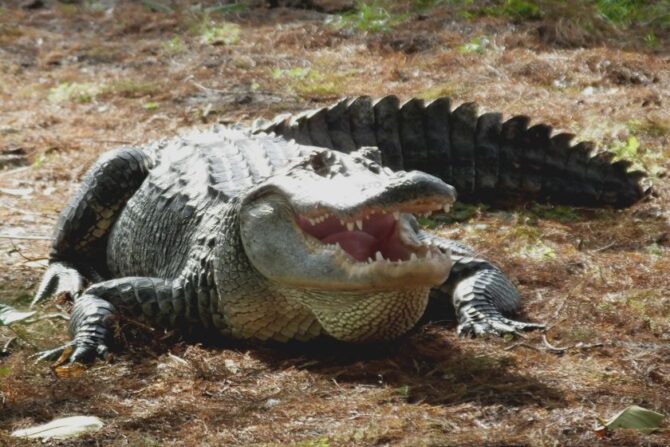
- Scientific name: Alligator mississippiensis
- Classification: Reptile
- Habitat: Freshwater and slow-moving water
- Diet: Carnivore
- Conservation status: Least concern
Although alligators are found in fresh waters, rivers, and ponds, it’s not out of place to see them sometimes appear on gulf beaches and other swimming areas.
In fact, there was a rare occurrence of a gator spotted swimming in the Gulf of Mexico.
Perhaps it’s because they are known to be drawn to splashing water, which indicates to Gators that a meal is nearby. So you never can tell when one or two may wander by.
As is the characteristics of Gators, the American Alligator has one of the strongest bite force in the world, with ferocious teeth and a bite strong enough to crack open a tortoise skull.
They can mature up to 14 feet in length with a life span of 30 years.
It should be common knowledge never to cross paths with this animal and if, unfortunately, you do, in the water, try to stay calm and make no sudden movement or splashing.
8. Hardhead Catfish

- Scientific name: Ariopsis felis
- Classification: Fish
- Habitat: Coastal waters
- Diet: Omnivore
- Conservation status: Least concern
Hardhead catfish are common in almost all Gulf coastal waters, which is why they are prevalent in the Gulf of Mexico.
Whether it’s pure salt or brackish waters, these fish species don’t have a problem making their habitat at all.
Although they cannot be classified as the aggressive type, thousands of people have been sent to the emergency room on their account annually.
They possess boney spines that protrude from the pectoral and dorsal fins, capable of sending painful doses of poison that can cause temporal paralysis if stung from one of their barbs.
Although the poisonous sting protects them from predators such as sharks, it can also harm you if you catch one of them with your fishing rod and try to feel it with your bare hand carelessly.
They are opportunists in nature and can eat almost anything on their path, be it plants or small fish. A dose of poison from them can cause swelling and numbness.
If you ever get bitten by this creature, please do NOT try to suck out the poison, as that will only worsen the risk of spread through the sinuses and throat.
The best treatment if medical care isn’t nearby is to allow the poison to wear out in a few hours, which it will, along with the pain.
9. Tiger Shark
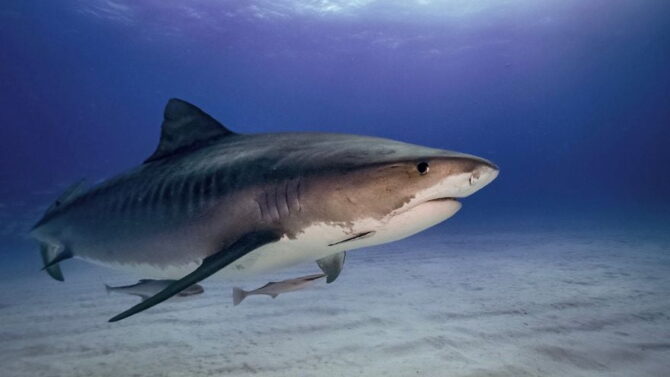
- Scientific name: Galeocerdo Cuvier
- Classification: Cartilaginous fish
- Habitat: Coastal waters
- Diet: Carnivore
- Conservation status: Near threatened
Sharks are among the most dangerous animals in the Gulf of Mexico.
For emphasis, we have decided to mention one name which should keep you on high alert when boating or surfing in the Mexican Gulf, and that is the Tiger Shark.
Seconded only to the Great White in aggression, this apex predator will eat almost anything it finds on its path.
As is the characteristic of most sharks, the Tiger Shark is a nocturnal hunter, but surprisingly, many of them come out during the day.
Some researchers have theorized that perhaps because of the many species of sharks, some try to avoid the other by running shifts.
These warning tips go for all sharks:
- Avoid wearing jewelry or anything shiny while swimming or surfing because sharks are attracted to light.
- Sharks are nocturnal and hunt at dusk and dawn, so try as much as possible not to make nighttime your swimming or surfing hours.
10. Great White Shark
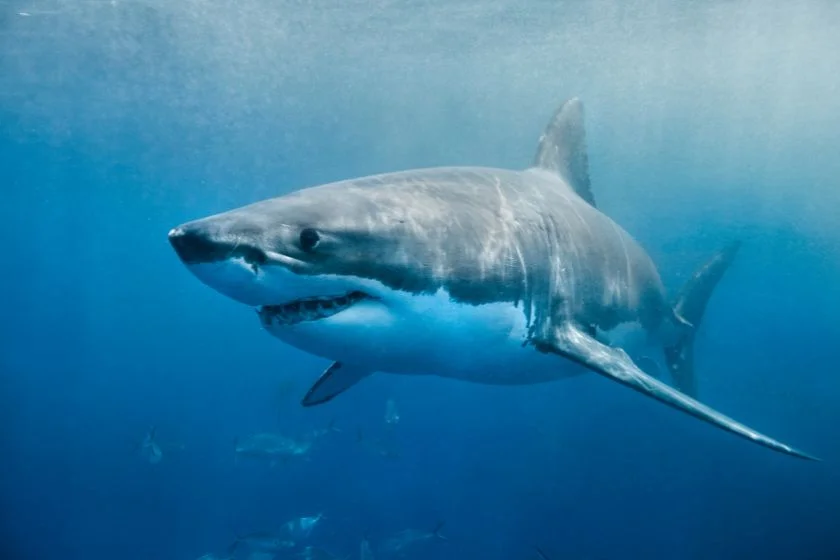
- Scientific name: Carcharodon carcharias
- Classification: Cartilaginous fish
- Habitat: Coastal waters
- Diet: Carnivore
- Conservation status: Vulnerable
If there is any shark in the world that gives swimmers and divers the chills despite their experience, then it’s the great white shark.
Growing up to 15 ft. in length and sometimes even 20 ft, weighing up to 5000 tons, this apex predator is one creature you don’t want to see having a go at you even in your wildest dreams.
Over 100-plus reported cases of sharks worldwide, and the great white is responsible for about a third of these attacks.
Although, it has later been discovered that most of these attacks weren’t intended to be fatal, but out of curiosity to sample out a meal as it’s the characteristics of sharks.
Fox 13 tells us of a captain sailing on the Gulf of Mexico, just outside Tampa Bay, whose boat was bitten by a shark, describing his experience as “one of the coolest things ever.”
The name great white shark was gotten from their white underbelly, and even if they aren’t common in the Gulf of Mexico, some of them have been tracked in the area from time to time.
Still speaking of how dangerous it is, the popular movie Jaws was inspired by this legendary creature.
So far, there has been a total documented record of 137 cases of shark attacks globally.
11. Portuguese Man O’ War
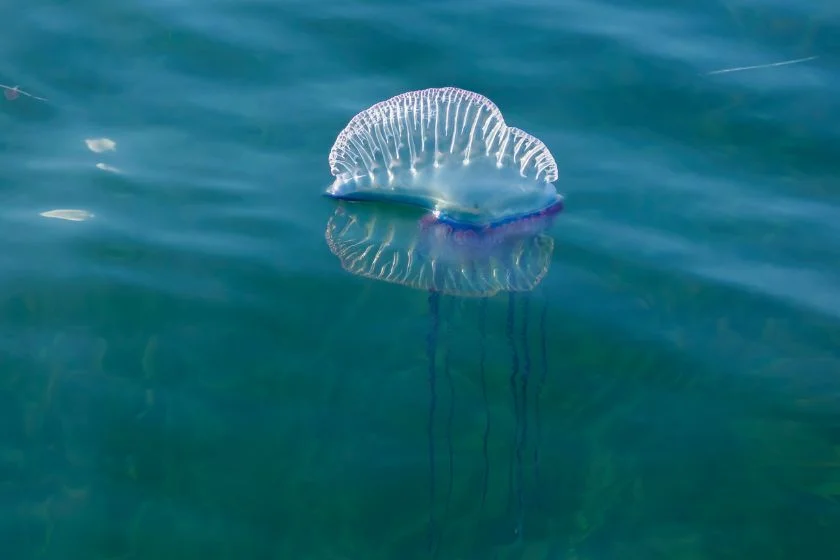
- Scientific name: Physalia physalis
- Classification: Invertebrates
- Habitat: Coastal waters
- Diet: Carnivore
- Conservation status: Not endangered
The Portuguese man o’ war may look like a jellyfish, but it’s not a jellyfish. It’s an assembly of tiny animals called zooids.
Each is designated with a distinctive task to carry out, such as feeding and breeding.
The name Portuguese man o’ war was inspired by the 18th-century Portuguese armed sailing ship, which many believed that they look alike when viewed at full sail.
Anyway, it’s the stinging tentacles you should be worried about because of those Medusa-looking tentacles, even though they may not be fatal.
Still, they surely have poison to cause you some serious discomfort.
Gulf of Mexico Wildlife Safety Tips
The Gulf of Mexico is a wonderful place to relax, conduct beach activities, and enjoy good wildlife viewing. But before you do, here are some safety tips you might need before visiting the legendary Mexican Gulf:
- Mind your footing and observe how you explore the sands because some might be home to some of these animals.
- Take along enough water and always stay hydrated because staying out for long under the scorching beach sun will get you dehydrated quickly.
- Observe beach safety warning flags: It will help you know the dangerous areas on the beach and how to avoid them.
Frequently Asked Questions
What is the deadliest animal in the Gulf of Mexico?
Jellyfish, especially the box jellyfish specie, is regarded as the most lethal and dangerous animal in the Gulf of Mexico.
And it is not only because they have the most dangerous venom in the world, but they are also common, which means you’re more likely to run into them in the Gulf of Mexico.
Are there crocodiles in the Gulf of Mexico?
Due to their nature, crocodiles cannot navigate the turbulent tides of the ocean, which is why they are a rare sight in the Gulf of Mexico.
But a study has shown that places like the Gulf Coast of Florida can support a favorable climate for Nile crocodiles.
Are there Piranhas in the Gulf of Mexico?
You’re more unlikely to encounter Piranhas in the Gulf of Mexico because they typically only live in South America, which is their habitat.
However, varying legalities of pets in countries can lead to finding a few in unusual habitats, so don’t be too surprised if you find one lurking in one of the Gulf waters.
Conclusion
The listed animals are not evil in and of themselves. They tend to avoid humans as much as possible and simultaneously play an important role in ecological balance.
However, the venom of some and the aggressive nature of others make them dangerous for humans.
Keep your distance, follow any guidelines you’re given, and you will be safe.






